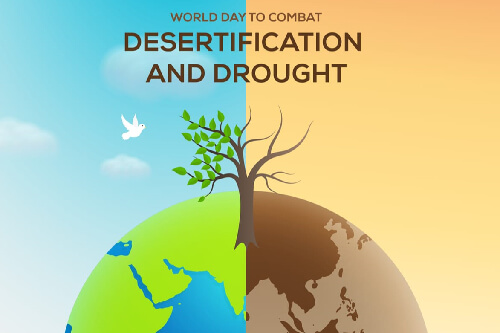
Message from Ms. Audrey Azoulay, Director-General of UNESCO, on the Occasion of World Day to Combat Desertification and Drought文章源自英文巴士-https://www.en84.com/11587.html
教科文组织总干事奥德蕾·阿祖莱防治荒漠化和干旱世界日致辞文章源自英文巴士-https://www.en84.com/11587.html
文章源自英文巴士-https://www.en84.com/11587.html
17 June 2021文章源自英文巴士-https://www.en84.com/11587.html
2021年6月17日文章源自英文巴士-https://www.en84.com/11587.html
文章源自英文巴士-https://www.en84.com/11587.html
Drought, climate change, biodiversity erosion, land degradation, intensive farming practices and poor water management, inter alia, have adversely affected our lands to the point of causing today’s global desertification crisis, which affects more than 165 countries worldwide.文章源自英文巴士-https://www.en84.com/11587.html
文章源自英文巴士-https://www.en84.com/11587.html
干旱、气候变化、生物多样性受损、土地退化、集约耕作以及水资源管理不善等问题,对我们的土地造成的不利影响如此之重,以致引发今天殃及世界上逾165个国家的全球荒漠化危机。文章源自英文巴士-https://www.en84.com/11587.html
文章源自英文巴士-https://www.en84.com/11587.html
This phenomenon has a dramatic impact on our common environmental heritage, and poses a considerable threat to the health of communities, global peace and sustainable development.
这场危机严重危害我们共同的环境遗产,并对人类健康、世界和平及可持续发展构成巨大威胁。
Desertification and drought, which are a degradation of environmental health, contribute to the collapse of biodiversity and favour the appearance of zoonoses. This is yet another reminder that human health and the health of our environment are deeply intertwined.
体现环境健康恶化的荒漠化和干旱,既加剧生物多样性的流失,同时也催生人畜共患疾病。这再次提醒我们,人类健康与环境健康密不可分。
As stated in the Global Assessment Report of the Intergovernmental Science-Policy Platform on Biodiversity and Ecosystem Services (IPBES), launched on 6 May 2019 at UNESCO, there is now an urgent need to take collective action to preserve the living fabric of our planet - and thus, in particular, to combat these phenomena.
正如生物多样性和生态系统服务政府间科学政策平台(生物多样性平台)于2019年5月6日在教科文组织发布的全球评估报告所言,我们需要紧急采取集体措施,保护地球的生命机体,特别是要防治荒漠化和干旱。
Desertification and drought also increase water scarcity, at a time when two billion people still lack access to safe drinking water – and over three billion may have to confront a similar situation by 2050.
荒漠化和干旱也加剧了缺水问题:目前仍有二十亿人无法获得安全饮用水,到2050年这一数字可能会攀升至三十亿。
The world’s most vulnerable communities do not have their essential water needs met, sometimes causing them to migrate from lands that have become dry and barren. According to the Secretariat of the United Nations Convention to Combat Desertification, 135 million people are likely to migrate worldwide by 2030 as a result of the deterioration of lands.
由于基本用水需求得不到满足,世界上最弱势的群体往往不得不迁离业已干旱贫瘠的土地。根据《联合国防治荒漠化公约》秘书处的报告,到2030年,全球或将有1.35亿人因土地退化而背井离乡。
These migrations and deprivations are in turn a source of conflict and instability, demonstrating that desertification is also a fundamental challenge to peace.
这种移徙和匮乏反过来又成为冲突和不稳定的根源,由此证明荒漠化也是对和平的重大挑战。
Every year, on June 17, we celebrate World Day to Combat Desertification and Drought to raise public awareness of international efforts to stop land degradation.
因此,我们在每年6月17日纪念防治荒漠化和干旱世界日,以此提高公众对国际社会为避免土地继续退化所作努力的认识。
UNESCO has been at the forefront of this collective endeavour, drawing on its scientific expertise and deploying its water and environment programmes.
教科文组织以自身的科学专业知识为依托,利用其水和环境计划,始终走在这一集体努力的前列。
In particular, this means observing, measuring and understanding, to make public policies fit for purpose, and effective. In order to consider these phenomena as a whole, UNESCO is setting up systems for measuring and monitoring hazards, such as common indicators or local monitoring and warning systems, as well as focusing on vulnerabilities, particularly socio-economic ones, as we are not all equal in the face of this risk.
这尤其需要进行观察、测量和了解,从而使公共政策变得适切和有效。为了从总体上把握这些现象,教科文组织正在建立灾害测量和监测系统,例如共同指标,或地方灾害监测和预警系统,同时也关注脆弱性,特别是社会经济方面的脆弱性问题,因为面对灾害风险,我们并非人人平等。
Working together is crucial. No sustainable progress can be achieved without the participation of all stakeholders: public authorities, businesses, scientists, associations and citizens, especially the youngest.
共同行动,至关重要。如果没有公共当局、企业、科学家、协会以及公民,尤其是年轻人等所有相关各方的参与,就不可能取得任何可持续的进展。
Together, let us build a sustainable future so that the fertile lands of the past do not become deserts emptied of their populations and their biodiversity.
让我们一起建设一个可持续的未来,使曾经的沃土不致沦为人口及生物多样性尽失的荒漠。

